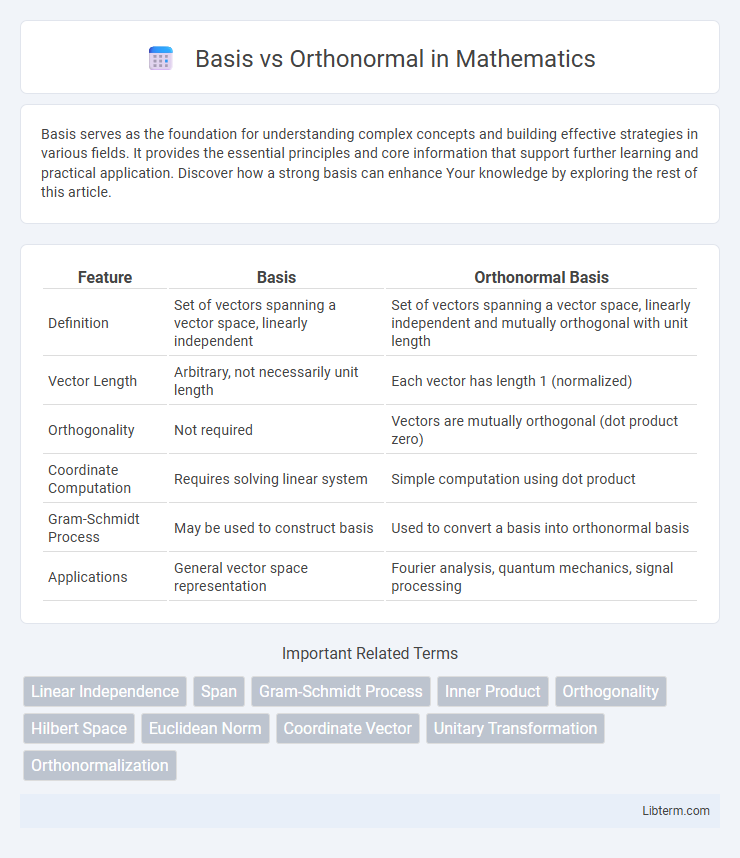Basis serves as the foundation for understanding complex concepts and building effective strategies in various fields. It provides the essential principles and core information that support further learning and practical application. Discover how a strong basis can enhance Your knowledge by exploring the rest of this article.
Table of Comparison
| Feature | Basis | Orthonormal Basis |
|---|---|---|
| Definition | Set of vectors spanning a vector space, linearly independent | Set of vectors spanning a vector space, linearly independent and mutually orthogonal with unit length |
| Vector Length | Arbitrary, not necessarily unit length | Each vector has length 1 (normalized) |
| Orthogonality | Not required | Vectors are mutually orthogonal (dot product zero) |
| Coordinate Computation | Requires solving linear system | Simple computation using dot product |
| Gram-Schmidt Process | May be used to construct basis | Used to convert a basis into orthonormal basis |
| Applications | General vector space representation | Fourier analysis, quantum mechanics, signal processing |
Introduction to Vector Spaces
A basis in a vector space is a set of vectors that are linearly independent and span the entire space, providing a unique representation for every vector in that space. An orthonormal basis is a specialized basis where vectors are both orthogonal (perpendicular) and normalized (unit length), simplifying computations with inner products. Understanding the distinction between general bases and orthonormal bases is fundamental in vector space theory, as it impacts vector decomposition, coordinate systems, and matrix representations.
What is a Basis?
A basis in linear algebra is a set of vectors in a vector space that are linearly independent and span the entire space, meaning every vector in the space can be uniquely expressed as a linear combination of basis vectors. Unlike an orthonormal basis, which requires vectors to be both orthogonal and normalized to unit length, a general basis does not impose these constraints. The dimension of the vector space equals the number of vectors in any basis for that space, providing a fundamental framework for vector representations and transformations.
Properties of a Basis
A basis of a vector space is a set of vectors that are linearly independent and span the entire space, allowing every vector to be uniquely represented as a linear combination of basis vectors. Unlike orthonormal bases, which require vectors to be both orthogonal and of unit length, a general basis does not impose orthogonality or normalization conditions. The defining properties of a basis ensure minimality and completeness, making it fundamental for coordinate systems and vector space dimension determination.
Defining Orthonormal Sets
Orthonormal sets are collections of vectors that are both orthogonal and of unit length, ensuring each pair of distinct vectors has a dot product of zero and each vector's norm equals one. This property simplifies calculations in vector spaces by providing a basis where vector components can be easily obtained through inner products. Unlike general bases, orthonormal bases enhance numerical stability and simplify matrix operations in fields such as linear algebra, signal processing, and quantum mechanics.
Basis vs Orthonormal: Core Differences
A basis in a vector space is a set of vectors that are linearly independent and span the entire space, allowing any vector to be uniquely represented as a linear combination of basis vectors. An orthonormal basis is a special type of basis where all vectors are not only orthogonal (perpendicular) to each other but also have unit length, simplifying calculations involving projections and inner products. The core difference lies in orthonormal bases facilitating easier computations and numerical stability, while general bases may require additional steps like the Gram-Schmidt process to achieve orthonormality.
Advantages of Using an Orthonormal Basis
Using an orthonormal basis simplifies computations in linear algebra by ensuring that vectors have unit length and are mutually perpendicular, which leads to easy calculation of vector projections and coefficients via dot products. This property reduces numerical errors and enhances stability in algorithms such as Fourier transforms and signal processing. Moreover, orthonormal bases facilitate efficient representation and reconstruction of data, making them essential in applications like principal component analysis and quantum mechanics.
Constructing an Orthonormal Basis (Gram-Schmidt Process)
Constructing an orthonormal basis from a set of linearly independent vectors is efficiently achieved using the Gram-Schmidt process, which systematically orthogonalizes and normalizes each vector. This method transforms an arbitrary basis into an orthonormal set by subtracting projections and dividing by the vector norm, ensuring vectors are both orthogonal and unit length. The resulting orthonormal basis simplifies computations in inner product spaces, enhancing numerical stability and interpretability in applications such as signal processing and quantum mechanics.
Applications in Mathematics and Physics
Basis sets provide a framework for representing vectors in linear algebra, enabling the decomposition of complex vector spaces into simpler components. Orthonormal bases, characterized by mutually perpendicular unit vectors, simplify calculations in quantum mechanics and Fourier analysis by ensuring straightforward inner product evaluations. Their application in solving differential equations, signal processing, and state vector representations in Hilbert spaces underscores their fundamental role in both mathematics and physics.
Visualizing Basis and Orthonormal Systems
Visualizing basis vectors involves picturing a set of linearly independent vectors spanning a vector space, where any vector can be expressed as a unique linear combination of these basis elements. Orthonormal systems take this concept further by ensuring vectors are not only linearly independent but also mutually perpendicular with unit length, simplifying projections and computations. Graphically, orthonormal bases appear as axes at right angles with equal scaling, enhancing clarity and ease in vector decomposition and transformations.
Conclusion: Choosing Between Basis and Orthonormal Basis
Choosing between a basis and an orthonormal basis depends on the application's requirements for computational efficiency and simplicity in calculations. An orthonormal basis simplifies operations such as projections and inner products due to its unit length and orthogonality properties, reducing complexity in linear algebra tasks. When speed and numerical stability are priorities, especially in signal processing or machine learning, an orthonormal basis is preferred over a general basis.
Basis Infographic

 libterm.com
libterm.com